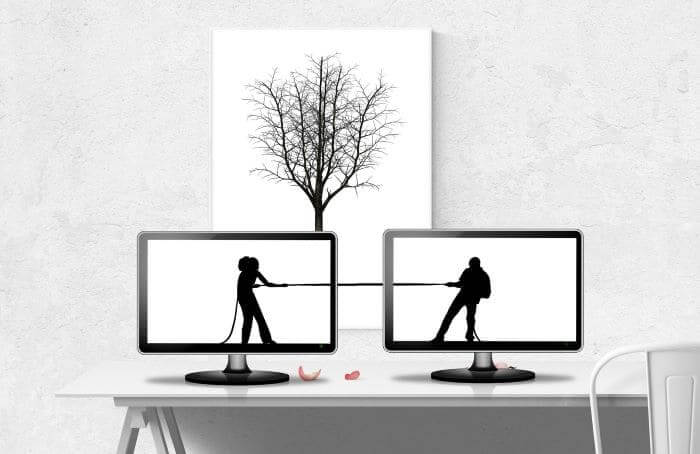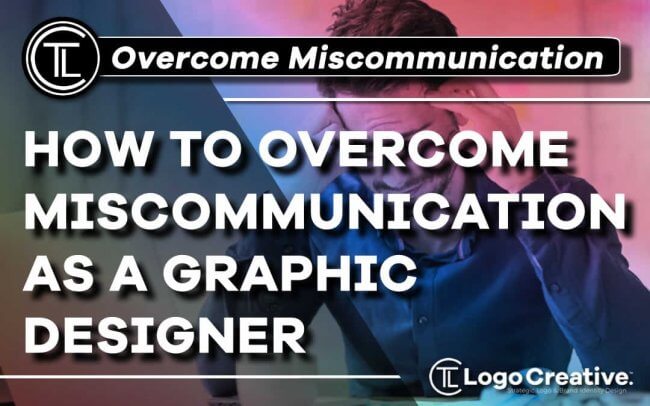Some of our favourite companies hand over the reins to their creative and visual projects to freelance graphic designers. And they’re gladly gripping them. However, many admit that working in a creative field on a freelance basis is quite different from working for an in-house team. In this article we discuss How to Overcome Miscommunication as a Graphic Designer.
As a freelance graphic designer, you can work with whomever you want. This is the best part for most. You get to treat each client as an individual.
The way you work with each one will be different. Still, a client-designer relationship free of mishaps and full communication is the goal when working with anyone.
If we’re honest, though, miscommunication will happen. So, it’s best to put yourself in a position where they can be resolved quickly. Here are six ways freelance graphic designers can overcome miscommunication with their clients and avoid them in the future.
Table of Contents
Always Hold an Initial Client Meeting

One of the best ways to avoid miscommunication with your clients is to meet with them. Therefore, you should always hold an initial client meeting to see if you fit them and the project.
An initial client meeting can help you find out:
- The project outline
- The client’s expectations for completion
- If the client has ever worked with freelancers before
- How they envision your working relationship
- If you’re personalities mesh
- If your working styles complement each other
- Any potential challenges in working together
- If you can overcome those challenges
Do way more listening than talking in your initial client meeting. Be sure to ask follow-up questions about anything you’re unsure about.
Once your initial client meeting is complete, you should have a good idea if you’re going to move forward with them. If you’ve decided to, it’s best to have another meeting or two to iron out the project details.
Iron out Project Details
Spend as much time as you need with your client putting together project details you’re both comfortable with. The more detailed you are about the project, the less room there is for miscommunications and misinterpretations. Over communicating is much better than under communicating.
Hammer out details like:
- What is the project?
- Who will be involved in completing it?
- Your specific responsibilities?
- How much and when will you be paid?
- When is the project due?
- Daily, weekly, monthly expectations?
- Project goals?
- What happens if the project isn’t completed on time?
- What to do if one party wants to cease partnership?
- When must the contract be accepted and signed?
- When did you start working?
- When does your contract end?
First, choose whether you’ll be putting these details together in-person or through a digital channel like email. When everything is hashed out, ensure all parties sign the contract and have a copy. After this, it’s best to go over communication expectations just once more before you get started.
Set Expectations for Communication Moving Forward
Setting expectations for communication moving forward is one of the best ways to ensure miscommunications are kept to a minimum and easily overcome if they do arise. Without firm standards for communication, you likely won’t have much communication at all.
Your communication expectations should cover:
- How often do you both expect communication?
- What days are you both working?
- What times are you working on those days?
- Best way to contact you in an emergency?
- Communication channel used for immediate responses?
- Communication channel used for things that can wait a day or two?
- If you plan to meet daily or weekly?
- Cut-off time for contact each day?
Especially if you’re just breaking into freelancing, make it a point to communicate as much as possible. Transparent communication makes it easier to determine how you work best together and complete the project in the most efficient way. Additionally, good communication gives you a better foundation to handle full-blown conflicts you’re having with a client and get good feedback.
Create a Feedback-Friendly Environment
Two-way communication is key to friendly relationships with your clients. You don’t have to guess when your client can openly give you feedback on what they like and don’t like. You can deliver the design clients expect when they expect it.
You can encourage feedback by:
- Letting your client know you want it
- Establish how much creative freedom you have
- Looping them into essential design decisions
- Check in with them before making a change
- Offering feedback only in the capacity they’ve asked for
- Give feedback only when it’s appropriate or asked for
Ultimately, make it a point to include them in what you do and give appropriate and beneficial feedback to the project.
Improve Your Emotional Intelligence
The strength of your client relationships is highly dependent on your emotional intelligence. Emotional intelligence “focuses on learning how to identify and manage your own emotions while maintaining empathetic interpersonal relationships with others.”
Having high emotional intelligence is crucial because:
- It helps you stay calm when others aren’t
- It helps you read between the lines and identify the root issue
- You remain solution-oriented
- You’re more likely to communicate openly
- It enables you to focus on active listening
- You understand even if you disagree
- You can de-escalate highly emotional situations faster
Improve emotional intelligence by:
- Reflecting on who you are, your strengths, and what you can improve
- Familiarize yourself with the basics of how to build high emotional intelligence
- Making emotional intelligence education continuous
- Focusing more on the positive than negative
- Enjoying the journey of improving emotional intelligence
In addition to improving your emotional intelligence, developing your soft skills will help you navigate miscommunications better.
Develop Your Soft Skills
Although technical skills are crucial to being a successful freelance graphic designer, soft skills are also precious. Freelancers benefit tremendously when they have excellent soft skills because they can listen to their clients, interpret what they want, and produce it.
Develop the following soft skills:
- Communication
- Compromise
- Collaboration
- Time management
- Problem-solving
- Critical thinking
- Active listening
- Creativity
Some soft skills will be easier than others to develop depending on your personality, but they’re all learnable.
Conclusion
Although we want to avoid miscommunications altogether, that’s just not realistic. Unfortunately, you’ll experience a miscommunication or two with clients at some point in your career, so prepare for them. Implement the above tips to ensure you’re ready to quickly resolve any issues with your clients with care and concern.
How did you overcome miscommunication with your clients? What steps are you taking to avoid them in the future?
Join The Logo Community
We hope you have enjoyed How to Overcome Miscommunication as a Graphic Designer. If you would like more personal tips, advice, insights, and access to our community threads and other goodies, join me in our community.
You can comment directly on the posts and have a discussion with Andrew, the Founder of The Logo Creative.
*TIP – We recommend The Freelance Starter Kit by Kady Sandel, It’s for graphic designers who are just starting their freelance business or have been in business for 1-2 years.


